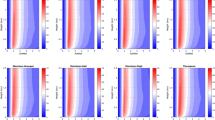Abstract
The physical characteristics of the summer monsoon clouds were investigated. The results of a simple cloud model were compared with the aircraft cloud physical observations collected during the summer monsoon seasons of 1973, 1974, 1976 and 1981 in the Deccan Plateau region.
The model predicted profiles of cloud liquid water content (LWC) are in agreement with the observed profiles. There is reasonable agreement between the model predicted cloud vertical thickness and observed rainfall.
The observed cloud-drop spectra were found to be narrow and the concentration of drops with diameter > 20μn is either low or absent on many occasions. In such clouds the rain-formation cannot take place under natural atmospheric conditions due to the absence of collision-coalescence process. A comparison of the model predicted and observed rainfall suggested that the precipitation efficiency in cumulus clouds of small vertical thickness could be as low as 20 per cent.
The clouds forming in the Deccan Plateau region during the summer monsoon are, by and large, cumulus and strato-cumulus type. The vertical thickness of the cumulus clouds is in the range of 1.0-2.0 km. The LWC is found to be more in the region between 1.6-1.9 km A. S. L., which corresponds to the level at almost 3 / 4 th of the total vertical thickness of the cloud and thereafter the LWC sharply decreased. Nearly 98 percent of the tops of the low clouds in the region are below freezing level and the most frequent range of occurrence of these cloud—tops is in the range of 2.0-3.0 km A. S. L. The dominant physical mechanism of rain-formation in these summer monsoon clouds is the collision-coalescence process.
Similar content being viewed by others
References
Ackerman Bernice (1967), The nature of the meteorological fluctuations in clouds,J. Appl. Meteor.,6: 61–71.
Cotton, W. R. (1972a), Numerical simulation of precipitation development in supercooled cumuli, Part I,Mon. Wea Rev.,100: 757–763.
Cotton, W. R. (1972b), Numerical simulation of precipitation development in supercooled cumuli, Part II,Mon. Wea. Rev.,100: 764–784.
Cotton, W. R. (1975), On parameterization of turbulent transport in cumulus clouds,J. Atmos. Sci.,32: 548–564.
Dutton, J. A. and G. H. Fichtl (1969), Approximate equations of motions of gases and liquids,J. Atmos. Sci.,26: 241–254.
Kapoor, R. K., S. K. Paul, A. S. R. Murty, K. Krishna, S. K. Sharma and Bh. V. R. Murty (1976), Measurments of cloud droplet sizse distributions in seeded warm cumulus clouds, PAGEOPH,114: 379–392.
Kessler, E. (1969), On the distribution and continuity of water substance in atmospheric circulation, Meteorological Monograph, 10,American Meteor. Soc., Boston, USA., 84 pp.
Manton, M. J. (1974), On the dispersion of a developing droplet spectrum in a turbulent cloud,Tellus,26: 489–494.
Maton, M. J. and W. R. Cotton (1977), Formulation of approximate equations for modelling moist deep convection on the mesoscale,Atmos. Sci., Paper No. 266, Colo. St. Univ., Ft. Collins, Colorado, USA, 62 pp.
Marshall, J. S. and W. M. Palmer (1948), The distribution of rain-drops with size,J. Meteor.,5: 165–166.
Mary Selvam A., A. S. R. Murty, R. Vijayakumar, S. K. Paul, G. K. Manohar, R. S. Reddy, B. K. Mukherjee and Bh. V. R. Murty (1980), Some thermodynamical and microphysieal aspects of monsoon clouds,Proc. Indian Academy of Sciences,89A: 215–230.
Pramanik, S. K. and P. Koteswaram (1955), Heights of tops of low clouds over India,Proc. Symposium on Artificial rain, C. S. I. R., New Delhi, India, 104–111.
Rogers, R. R. and M. K. Yau (1989),A short course in cloud physics, Third Edition, Pergament Press, New York, 293 pp.
Scott, W. T. and C. Chen (1970), Approximate formulae fitted to, the Davis-Sartor-Schafir-Neiburger droplet collision efficiency calculations,J. Atrnps. Sci.,27: 698–700.
Simpson, J., R. H. Simpson, D. A. Andrews, and M. A. Eaton (1965), Experimental cumulus dynamics,Rev. Geophysics,3: 387–431.
Simpson, J. (1976), Precipitation augumentation from cumulus clouds and, systems: Scientific and Technological foundations, 1975:Rev. Geophysics,19: 1–72
Skatskii, V. I. (1963), An airborne water—content meter for clouds with sufficient liquid to form droplets,Izv. Akad. Nauk SSSR Ser. geofiz., No. 9 (English edn. p. 885).
Squires, P. (1956), The micro-structure of cumuli in maritime and continental air,Tellus,8: 443–444.
Warner, J., (1970), On steady state one-dimensional models of cumulus convection,J. Atmos. Sci.,27: 1035–1040.
Author information
Authors and Affiliations
Rights and permissions
About this article
Cite this article
Selvam, A.M., Vijayakumar, R. & Murty, A.S.R. Some physical aspects of summer monsoon clouds—comparison of cloud model results with observations. Adv. Atmos. Sci. 8, 111–124 (1991). https://doi.org/10.1007/BF02657370
Received:
Revised:
Issue Date:
DOI: https://doi.org/10.1007/BF02657370



